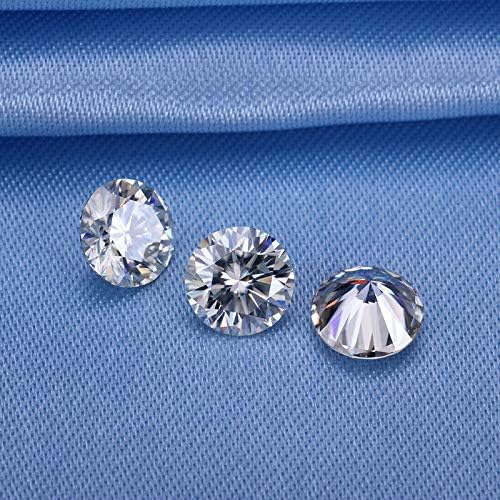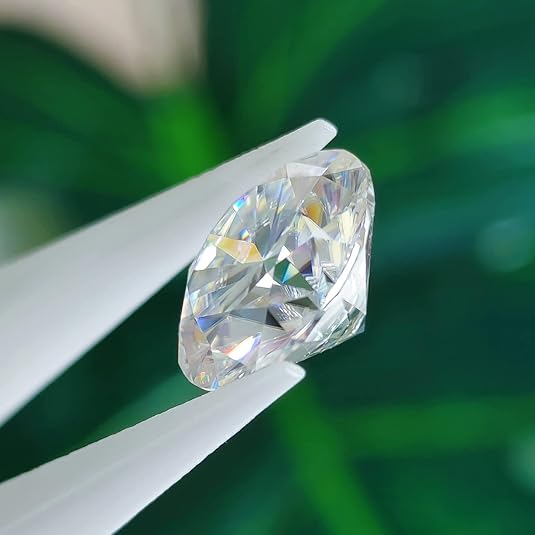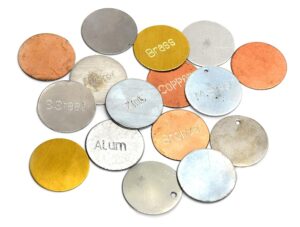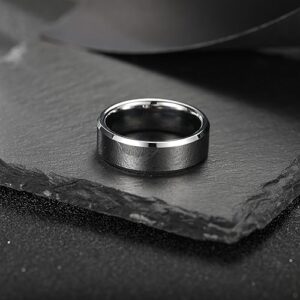Imagine wearing a gemstone that was first discovered in a meteorite. Sounds like science fiction, right?
Well, that’s the magical origin of moissanite — a stone that’s dazzling jewelry lovers around the world with its brilliance, beauty, and better price tag.
And here’s the best part: while its cosmic discovery makes moissanite fascinating, its modern-day version is created in labs, not in mines. That means it’s eco-friendly, conflict-free, and absolutely stunning.
So, let’s get into the sparkling world of moissanite. Ready to see how science creates beauty?
Table of Contents
What Is Moissanite?
Moissanite Is Lab-Grown Silicon Carbide
At its core, moissanite is a gemstone made of silicon carbide (SiC) — a super rare mineral in nature, but grown in labs with cutting-edge technology today.
But what makes moissanite even cooler?
It’s man-made. Scientists recreate it in a lab using advanced technology — making it a real gemstone that’s also modern and sustainable. It has an intense sparkle, great durability, and an affordable price — all wrapped up in one guilt-free, glittering stone.
Why Is Moissanite Made in Labs?
You might wonder, if moissanite was first found in a meteorite, why don’t we just get it from space or nature?
The truth is, natural moissanite is extremely rare. The tiny crystals discovered by Dr. Henri Moissan back in 1893 were too small to be used as gemstones.
That’s why scientists grow moissanite in labs today. Using advanced technology, they create high-quality moissanite crystals that are big enough and perfect for jewelry.
Even though moissanite is lab-made, it’s still made from the same mineral found in nature. This process avoids mining, helps protect the environment, and ensures the stones are top quality.
How Is Moissanite Made? (Step-by-Step)
Have you ever wondered how moissanite gets its incredible sparkle?
Let’s walk through the fascinating process—from raw ingredients to the stunning gem you see in jewelry stores.
Step 1: Raw Ingredients – Where It All Begins
Moissanite starts with just two natural elements: silicon and carbon.
When combined under the right conditions, they form a strong compound called silicon carbide (SiC)—the secret behind moissanite’s hardness and brilliance.
Depending on the method used, this compound is prepared either as a powder or a gas before crystal growth begins.
Step 2: Growing the Crystal – HPHT or CVD
To turn those elements into a crystal, labs use one of two advanced methods. Let’s break them down simply:
HPHT (High Pressure, High Temperature)
This method mimics how crystals form in nature—but inside a lab.
The silicon carbide is placed under extreme pressure and heat (over 2,000°C!), causing the atoms to arrange into crystal form. It’s like growing a gem in a mini version of Earth’s core.
CVD (Chemical Vapor Deposition)
CVD works differently.
It uses gas chemicals inside a vacuum chamber to slowly build the crystal. Think of it like 3D-printing a gemstone—growing it layer by layer on a small “seed” crystal.
This method is very controlled, so the crystals grow with fewer flaws.
Step 3: Crystal Growth Phase
Once the process begins, it takes several weeks for the crystal to fully grow.
During this time, labs carefully monitor the temperature, pressure, and purity to make sure the crystal grows evenly and doesn’t develop imperfections.
Step 4: Cutting and Polishing
After the crystal is ready, it’s handed over to skilled gemstone cutters.
This is where the magic happens. Expert cutters carefully shape and facet the moissanite to maximize brilliance and fire—the flashes of rainbow light you see when it hits the sun. Each cut is planned with precision to bring out that dazzling sparkle.
Step 5: Grading and Quality Control
Before a moissanite ever reaches a ring or necklace, it goes through strict quality checks.
Gemologists inspect each stone for:
- Clarity (Is it clear and free from flaws?)
- Color (Moissanite is often near-colorless or graded on the D–K scale like diamonds)
- Brilliance (Does it shine and sparkle properly?)
Only the best stones are selected to become jewelry.
Moissanite vs. Diamond vs. Cubic Zirconia (CZ)
| Feature | Moissanite | Diamond | Cubic Zirconia (CZ) |
|---|---|---|---|
| Brilliance | Very high, with colorful rainbow fire. | High, with classic white sparkle. | Moderate, can appear glassy. |
| Hardness | 9.25 on Mohs scale – very durable. | 10 – hardest natural material. | 8–8.5 – more prone to scratches. |
| Cost | More affordable than diamonds. | Very expensive, especially natural ones. | Very inexpensive and widely available. |
| Durability | Strong and chip-resistant. | Extremely tough and long-lasting. | Less durable, may dull or chip over time. |
| Color Options | Available in near-colorless and fancy tones. | Found in various natural and rare colors. | Comes in many colors, but often looks artificial. |
| Clarity | Usually high clarity, minimal flaws. | May have inclusions; graded for clarity. | Flawless but may look too perfect. |
| Heat Resistance | Handles heat well, safe for repairs. | Highly heat-resistant. | Can cloud or crack with heat. |
| Weight | Lighter than diamond and CZ. | Moderate, natural feel. | Heaviest of the three for same size. |
| Popularity | Gaining popularity as a diamond alternative. | Most traditional and valued gem. | Common in fashion jewelry, not for heirlooms. |
Frequently Asked Question's
Moissanite is a real gemstone, but most moissanite used in jewelry today is lab-created. Natural moissanite is extremely rare and was first discovered in a meteor crater. To make it more available and affordable, scientists recreate it in labs using silicon and carbon.
No, moissanite is not a fake diamond—it’s a completely different gemstone with its own unique properties. While it looks similar to a diamond and has strong sparkle, it’s made from silicon carbide, not carbon like diamonds.
It usually takes 4 to 8 weeks to grow a moissanite crystal in a lab, depending on the method used:
- HPHT (High Pressure, High Temperature): This method is faster and typically takes around 4 to 6 weeks to grow a usable moissanite crystal.
- CVD (Chemical Vapor Deposition): This is a slower but more controlled method and can take 6 to 8 weeks or longer, especially for higher-quality or larger stones.
The exact time also depends on the desired size, clarity, and color of the final gemstone. Larger or higher-quality crystals take longer to grow.
One downside is that moissanite can show more rainbow-like sparkle (called “fire”) than diamonds, which some people feel looks less natural. Also, since it’s not as traditional as diamonds, some may view it as less valuable for engagement rings, even though it’s very durable and beautiful.
Yes, most professional jewelers can tell the difference between moissanite and diamond using special tools. Moissanite and diamond have different light reflections, and moissanite will often test differently with diamond testers.
Yes, in many ways, moissanite is better than cubic zirconia (CZ). It’s harder (more durable), more brilliant, and lasts much longer. While CZ is cheaper, it scratches and dulls more easily over time. Moissanite is a better choice if you want a long-lasting, diamond-like gem.





